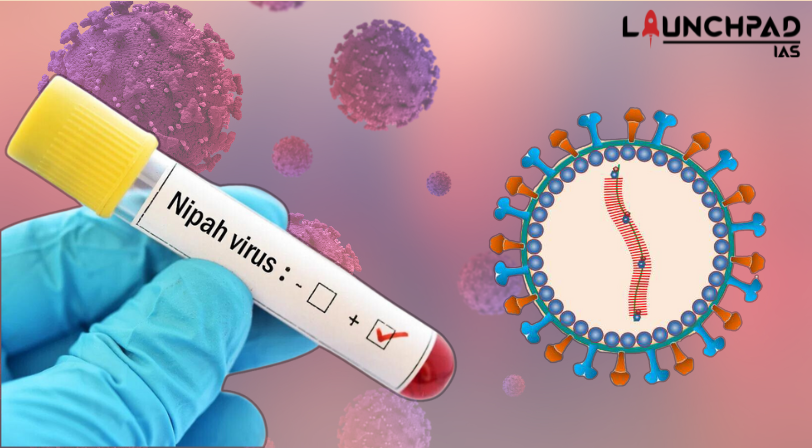About
- Nipah Virus is a zoonotic virus (it is transmitted from animals to humans).
- The organism that causes Nipah Virus encephalitis is an RNA or Ribonucleic acid virus of the family Paramyxoviridae, genus Henipavirus, and is closely related to Hendra virus.
- Hendra virus (HeV) infection is a rare emerging zoonosis that causes severe and often fatal diseases in infected horses and humans.
- It first broke out in Malaysia and Singapore in 1998 and 1999.
- The disease is named after a village in Malaysia, Sungai Nipah, where it was first detected.
- It first appeared in domestic pigs and has been found in several species of domestic animals, including dogs, cats, goats, horses, and sheep.
Transmission
- The disease spreads through fruit bats, or ‘flying foxes,’ of the genus Pteropus, natural reservoir hosts of the Nipah and Hendra viruses.
- The virus is present in bat urine, feces, saliva, and birthing fluids.
Symptoms of Nipah Virus
The human infection presents as an encephalitic syndrome marked by fever, headache, drowsiness, disorientation, mental confusion, coma, and potentially death.
Prevention
Currently, there are no vaccines for both humans and animals. Intensive supportive care is given to humans infected by the Nipah virus.
Zoonotic Disease
- The word ‘Zoonosis’ (Pleural: Zoonoses) was introduced by Rudolf Virchow in 1880 to collectively describe the diseases shared in nature by man and animals.
- Later, the World Health Organisation (WHO) in 1959 defined Zoonoses as those diseases and infections that are naturally transmitted between vertebrate animals and man.
- Zoonoses may be bacterial, viral, or parasitic or may involve unconventional agents.
- As well as being a public health problem, many of the major zoonotic diseases prevent the efficient production of food of animal origin and create obstacles to international trade in animal products.
How do Germs Spread between Animals and People?
- Zoonotic transmission can occur in any context in which there is companionship (pets), economic (farming, etc.), predatory (hunting, butchering, or consuming wild game), or research contact with animals.
- Contamination of food or water supply: Eating or drinking contaminated food can cause various types of diseases in humans.
- Direct contact: While petting or touching animals, and bites or scratches.
- Indirect contact: Coming into contact with areas where animals live and roam.
- Vector-borne: Being bitten by a tick or an insect, like a mosquito or a flea; food-borne
Types of Influenza in Animals
- Most strains of influenza that infect humans are human diseases, although many strains of bird flu and swine flu are zoonoses.
- Influenza: Viruses are found in many different animals, including ducks, chickens, pigs, whales, horses, seals, and cats.
- These viruses occasionally recombine with human strains of the flu and can cause pandemics.
- Bat influenza:
- Influenza A viruses are found in bats.
- Bat flu was first discovered in “little Yellow-shouldered bats” in Guatemala.
- Internal genes of bat flu viruses are compatible with human flu viruses
- Influenza in cats:
- Cats can be infected with influenza viruses, including avian influenza viruses.
- Influenza in cats is thought to spread the same way that human flu spreads: through direct contact.
- Canine influenza (dog flu):
- A contagious respiratory disease in dogs caused by specific type A influenza viruses — H3N8, H3N2.
- No human infections with canine influenza have ever been reported.
- Swine/Variant influenza: A respiratory disease of pigs caused by type A influenza viruses.
- Avian influenza:
- These viruses occur naturally among wild aquatic birds worldwide and can infect domestic poultry and other bird and animal species.
- All subtypes of influenza A viruses apart from H17N10 and H18N11 can infect birds.
Classification of Zoonoses
According to the Etiological (Originating) Agents
- Bacterial zoonoses: e.g., anthrax, brucellosis, plague, leptospirosis, salmonellosis, Lyme disease
- Viral zoonoses: e.g., rabies, arbovirus infections, KFD, yellow fever, influenza
- Rickettsial zoonoses: e.g., murine typhus, tick typhus, scrub typhus, Q-fever
- Protozoal zoonoses: e.g., toxoplasmosis, trypanosomiasis, leishmaniasis
- Helminthic zoonoses: e.g., echinococcosis (hydatid disease), taeniasis
- Fungal zoonose: s e.g., deep mycosis – histoplasmosis, cryptococcosis
- Ectoparasites: e.g., scabies, myiasis
According to the Mode of Transmission
- Direct zoonoses: Transmitted from an infected vertebrate host to a susceptible host (man) by direct contact, by contact with a fomite or by a mechanical vector. Eg: rabies, anthrax, brucellosis etc.
- Cyclozoonoses: Require more than one vertebrate host species, but no invertebrate host for the completion of the life cycle of the agent, e.g. echinococcosis, taeniasis.
- Metazoonoses: These are transmitted biologically by invertebrate vectors, in which the agent multiplies and/or develops and there is always an extrinsic incubation (prepatent) period before transmission to another vertebrate host e.g., plague.
- Saprozoonoses: These require a vertebrate host and a non-animal developmental site like soil, plant material, pigeon dropping etc. for the development of the infectious agent e.g. aspergillosis.
Prevention Strategies
- Multisectoral collaboration is essential in preventing and controlling zoonotic diseases.
- The “One Health” approach emphasizes the collaboration between human health, animal health, and environmental sectors.
- Early detection and surveillance systems for zoonotic diseases play a crucial role in preventing outbreaks and epidemics.
- Promoting hygiene practices, such as proper handwashing, food safety measures, and safe handling of animals, helps reduce the risk of transmission.
- Vaccination programs for animals, especially those in close contact with humans, can be effective in preventing zoonotic diseases.
- Improving public awareness and education about zoonotic diseases and their prevention is vital in promoting responsible behavior and reducing the risk of transmission.


